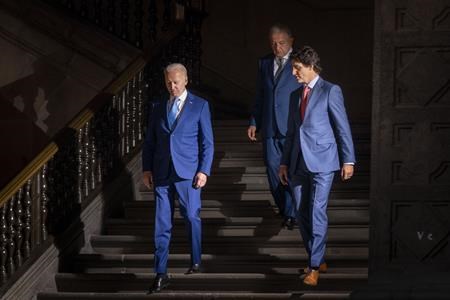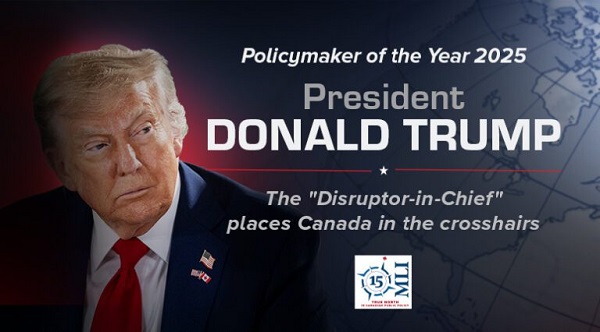Alberta
U.S. President Joe Biden’s long-awaited Canada visit to happen March 23-24

WASHINGTON — U.S. President Joe Biden will travel to Ottawa on March 23 to meet with Prime Minister Justin Trudeau on Canadian soil, his first visit north of the border since taking the oath of office in 2021.
The White House said the president and his wife Jill Biden will spend two days in Canada, although a detailed itinerary has not yet been released.
The two leaders will discuss an ongoing upgrade of the jointly led Norad continental defence system, which came under heavy scrutiny last month following the discovery of a Chinese surveillance balloon over U.S. and Canadian airspace.
They will also discuss how to fortify shared supply chains, combat climate change and “accelerate the clean energy transition,” the White House said in a statement.
Biden will also address a joint session of Parliament “to highlight the importance of the United States-Canada bilateral relationship.”
A visit to Canada is customarily one of a new U.S. president’s first foreign trips, a tradition upended two years ago by the COVID-19 pandemic. Like the rest of the world at the time, the two leaders settled for a virtual meeting instead.
The virus interfered in Canada-U.S. relations again in 2022, when Biden tested positive for COVID a second time, forcing the White House to scrap its plan for a summertime visit that year.
Delayed though it may be, it will be an important bilateral meeting for both countries, said Scotty Greenwood, CEO of the Canadian American Business Council.
“It’s an occasion which focuses a bureaucracy on the breadth and depth of bilateral and multilateral issues … and that’s a really good thing, because it causes everybody here to focus on Canada,” Greenwood said.
“It also allows the president himself to think about and reflect on Canada in the context of all the other global relationships the U.S. has, and that can be a very good thing.”
In the end, however, it’s essential that the federal government in Ottawa make the most of the opportunity, she added.
“The extent to which Canada wants to lean in and try to help solve some of the pain points the U.S. has is a good opportunity for Canada,” Greenwood said. “We won’t know until the visit happens if Canada wants to do that.”
As always, the two leaders have a lot to talk about — much of it a direct offshoot of the pandemic as both countries recalibrate their domestic and international supply chains, bilateral travel rules and economic recovery efforts, all of it with an eye toward arresting the march of climate change around the world.
Strategies to minimize dependence on China for critical minerals and semiconductors, two vital components in the global push to expand the popularity of electric vehicles and fuel what some experts liken to a post-pandemic industrial revolution, are sure to be high on the agenda.
So too will be a united front in opposing Russia’s continued aggression in Ukraine, as well as what to do about Haiti, where Canada is facing international pressure to take a lead role in quelling widespread gang violence.
There will be bilateral tensions to address as well.
The post-NAFTA era, where the U.S.-Mexico-Canada Agreement is now the law of the land in continental trade, has been marked by irritants, including access to Canada’s dairy market and how the U.S. defines foreign content in autos.
Immigration has also become a hot topic: while Republican lawmakers usually have a singular focus on the flow of migrants across the U.S.-Mexico border, a spike in the number of people entering from Canada has also caught their eye.
Trudeau has publicly acknowledged that the two countries need to renegotiate the 2004 Safe Third Country Agreement in order to staunch the flow of irregular migration into Canada, but there’s little appetite in the U.S. to do so.
Even so-called trusted travellers are having a harder time than they did before the pandemic, with the fast-track program known as Nexus having been hampered by a cross-border jurisdictional squabble.
The White House said “irregular migration and forced displacement throughout the region” will indeed be on the agenda, but offered no additional details.
Biden’s speech to Parliament will follow in the footsteps of his former boss, then-president Barack Obama, who made a similar address when he last visited Ottawa in June of 2016.
Biden himself visited the national capital in December of that year, as Obama’s second term was winding down and the world was bracing for the inauguration of his Republican successor, Donald Trump.
“I know sometimes we’re like the big brother that’s a pain in the neck and overbearing … but we’re more like family, even, than allies,” the vice-president at the time said during a state dinner in his honour.
He cheered Canada’s role in defending and strengthening what he called a “liberal international order” amid the rise of authoritarianism around the world, perhaps sensing what the next four years had in store.
“We’re going to get through this period because we’re Americans and Canadians, and so had I a glass I’d toast you by saying, ‘Vive le Canada,’ because we need you very, very badly.”
This report by The Canadian Press was first published March 9, 2023.
James McCarten, The Canadian Press
Alberta
Ottawa-Alberta agreement may produce oligopoly in the oilsands

From the Fraser Institute
By Jason Clemens and Elmira Aliakbari
The federal and Alberta governments recently jointly released the details of a memorandum of understanding (MOU), which lays the groundwork for potentially significant energy infrastructure including an oil pipeline from Alberta to the west coast that would provide access to Asia and other international markets. While an improvement on the status quo, the MOU’s ambiguity risks creating an oligopoly.
An oligopoly is basically a monopoly but with multiple firms instead of a single firm. It’s a market with limited competition where a few firms dominate the entire market, and it’s something economists and policymakers worry about because it results in higher prices, less innovation, lower investment and/or less quality. Indeed, the federal government has an entire agency charged with worrying about limits to competition.
There are a number of aspects of the MOU where it’s not sufficiently clear what Ottawa and Alberta are agreeing to, so it’s easy to envision a situation where a few large firms come to dominate the oilsands.
Consider the clear connection in the MOU between the development and progress of Pathways, which is a large-scale carbon capture project, and the development of a bitumen pipeline to the west coast. The MOU explicitly links increased production of both oil and gas (“while simultaneously reaching carbon neutrality”) with projects such as Pathways. Currently, Pathways involves five of Canada’s largest oilsands producers: Canadian Natural, Cenovus, ConocoPhillips Canada, Imperial and Suncor.
What’s not clear is whether only these firms, or perhaps companies linked with Pathways in the future, will have access to the new pipeline. Similarly, only the firms with access to the new west coast pipeline would have access to the new proposed deep-water port, allowing access to Asian markets and likely higher prices for exports. Ottawa went so far as to open the door to “appropriate adjustment(s)” to the oil tanker ban (C-48), which prevents oil tankers from docking at Canadian ports on the west coast.
One of the many challenges with an oligopoly is that it prevents new entrants and entrepreneurs from challenging the existing firms with new technologies, new approaches and new techniques. This entrepreneurial process, rooted in innovation, is at the core of our economic growth and progress over time. The MOU, though not designed to do this, could prevent such startups from challenging the existing big players because they could face a litany of restrictive anti-development regulations introduced during the Trudeau era that have not been reformed or changed since the new Carney government took office.
And this is not to criticize or blame the companies involved in Pathways. They’re acting in the interests of their customers, staff, investors and local communities by finding a way to expand their production and sales. The fault lies with governments that were not sufficiently clear in the MOU on issues such as access to the new pipeline.
And it’s also worth noting that all of this is predicated on an assumption that Alberta can achieve the many conditions included in the MOU, some of which are fairly difficult. Indeed, the nature of the MOU’s conditions has already led some to suggest that it’s window dressing for the federal government to avoid outright denying a west coast pipeline and instead shift the blame for failure to the Smith government.
Assuming Alberta can clear the MOU’s various hurdles and achieve the development of a west coast pipeline, it will certainly benefit the province and the country more broadly to diversify the export markets for one of our most important export products. However, the agreement is far from ideal and could impose much larger-than-needed costs on the economy if it leads to an oligopoly. At the very least we should be aware of these risks as we progress.

Elmira Aliakbari
Alberta
A Christmas wish list for health-care reform

From the Fraser Institute
By Nadeem Esmail and Mackenzie Moir
It’s an exciting time in Canadian health-care policy. But even the slew of new reforms in Alberta only go part of the way to using all the policy tools employed by high performing universal health-care systems.
For 2026, for the sake of Canadian patients, let’s hope Alberta stays the path on changes to how hospitals are paid and allowing some private purchases of health care, and that other provinces start to catch up.
While Alberta’s new reforms were welcome news this year, it’s clear Canada’s health-care system continued to struggle. Canadians were reminded by our annual comparison of health care systems that they pay for one of the developed world’s most expensive universal health-care systems, yet have some of the fewest physicians and hospital beds, while waiting in some of the longest queues.
And speaking of queues, wait times across Canada for non-emergency care reached the second-highest level ever measured at 28.6 weeks from general practitioner referral to actual treatment. That’s more than triple the wait of the early 1990s despite decades of government promises and spending commitments. Other work found that at least 23,746 patients died while waiting for care, and nearly 1.3 million Canadians left our overcrowded emergency rooms without being treated.
At least one province has shown a genuine willingness to do something about these problems.
The Smith government in Alberta announced early in the year that it would move towards paying hospitals per-patient treated as opposed to a fixed annual budget, a policy approach that Quebec has been working on for years. Albertans will also soon be able purchase, at least in a limited way, some diagnostic and surgical services for themselves, which is again already possible in Quebec. Alberta has also gone a step further by allowing physicians to work in both public and private settings.
While controversial in Canada, these approaches simply mirror what is being done in all of the developed world’s top-performing universal health-care systems. Australia, the Netherlands, Germany and Switzerland all pay their hospitals per patient treated, and allow patients the opportunity to purchase care privately if they wish. They all also have better and faster universally accessible health care than Canada’s provinces provide, while spending a little more (Switzerland) or less (Australia, Germany, the Netherlands) than we do.
While these reforms are clearly a step in the right direction, there’s more to be done.
Even if we include Alberta’s reforms, these countries still do some very important things differently.
Critically, all of these countries expect patients to pay a small amount for their universally accessible services. The reasoning is straightforward: we all spend our own money more carefully than we spend someone else’s, and patients will make more informed decisions about when and where it’s best to access the health-care system when they have to pay a little out of pocket.
The evidence around this policy is clear—with appropriate safeguards to protect the very ill and exemptions for lower-income and other vulnerable populations, the demand for outpatient healthcare services falls, reducing delays and freeing up resources for others.
Charging patients even small amounts for care would of course violate the Canada Health Act, but it would also emulate the approach of 100 per cent of the developed world’s top-performing health-care systems. In this case, violating outdated federal policy means better universal health care for Canadians.
These top-performing countries also see the private sector and innovative entrepreneurs as partners in delivering universal health care. A relationship that is far different from the limited individual contracts some provinces have with private clinics and surgical centres to provide care in Canada. In these other countries, even full-service hospitals are operated by private providers. Importantly, partnering with innovative private providers, even hospitals, to deliver universal health care does not violate the Canada Health Act.
So, while Alberta has made strides this past year moving towards the well-established higher performance policy approach followed elsewhere, the Smith government remains at least a couple steps short of truly adopting a more Australian or European approach for health care. And other provinces have yet to even get to where Alberta will soon be.
Let’s hope in 2026 that Alberta keeps moving towards a truly world class universal health-care experience for patients, and that the other provinces catch up.
-

 Artificial Intelligence2 days ago
Artificial Intelligence2 days agoUK Police Pilot AI System to Track “Suspicious” Driver Journeys
-

 Business2 days ago
Business2 days agoJudge Declares Mistrial in Landmark New York PRC Foreign-Agent Case
-

 Business2 days ago
Business2 days agoThe “Disruptor-in-Chief” places Canada in the crosshairs
-

 Energy14 hours ago
Energy14 hours ago‘The electric story is over’
-

 International24 hours ago
International24 hours agoGeorgia county admits illegally certifying 315k ballots in 2020 presidential election
-

 Digital ID2 days ago
Digital ID2 days agoCanadian government launches trial version of digital ID for certain licenses, permits
-

 Alberta21 hours ago
Alberta21 hours agoA Christmas wish list for health-care reform
-

 International2 days ago
International2 days agoWorld-leading biochemist debunks evolutionary theory










